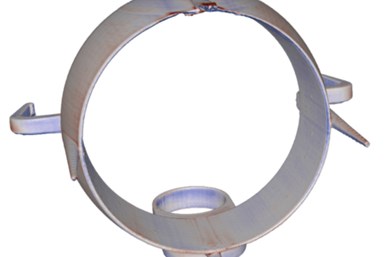Accurate Digital Manufacturing Tool for 3D Printed Parts
Warp-Adapted-Model uses full-part 3D data from an initial part to identify errors and produce a new, corrected model in minutes.
Share







Riven, a leader in 3D reality intelligence for digital manufacturing, has developed Warp-Adapted-Model (WAM) capability that is said to enable higher accuracy additive manufacturing (AM) part production. WAM uses full-part 3D data from an initial part to identify errors and produce a new, corrected model in minutes. According to Riven, the resulting model eliminates warp and is up to 10 times more accurate when printed.
WAM capability has been tested extensively and has shown improvement across a wide variety of additive manufacturing technologies including fused filament fabrication (FFF), stereolithography (SLA), metal binder jetting and multi jet fusion (MJF). WAM is said to improve parts made by nearly any AM technology or machine, including legacy equipment.
WAM works for any additive technology without the need for detailed knowledge of the specific machine or material parameters. WAM is complementary to simulation-based approaches and can be used alone or in combination to correct remaining errors related to environmental conditions or imperfect simulation input.
In a comprehensive FFF trial, average print errors were reduced by over 2.8 times where the accuracy score improved from 80% to 93% (where errors are defined as areas with deviation over 0.25 mm). Trials were conducted with three different part types and in three different materials.
According to Riven, WAM is scalable, making additive manufacturing a viable option for customers with projects that only need a few units to those that require thousands or more. Riven is developing joint solutions with leading AM equipment and additive manufacturing of electronic systems (AMES) partners to open new markets for AM production across industrial, automotive, aerospace and consumer applications.
Riven is also pre-release testing PWAM, a predictive, machine-learning driven version of the technology which creates pre-adjusted models automatically and will deliver even greater economies of scale and minimize production of scrap parts.
Related Content
-
Machine Tool Drawbar Made With Additive Manufacturing Saves DMG MORI 90% Lead Time and 67% CO2 Emission
A new production process for the multimetal drawbar replaces an outsourced plating step with directed energy deposition, performing this DED along with roughing, finishing and grinding on a single machine.
-
Push-Button DED System Aims for Machine Shop Workflow in Metal Additive Manufacturing
Meltio M600 metal 3D printer employs probing, quick-change workholding and wire material stock to permit production in coordination with CNC machines.
-
The Downloadable Metal 3D Printer
Copenhagen researchers introduce a fully open-source laser powder bed fusion system, now available on GitHub. This release follows their development of an open-source vat polymerization machine. Here is the purpose and promise of this philanthropically funded effort to advance additive manufacturing application and adoption.















